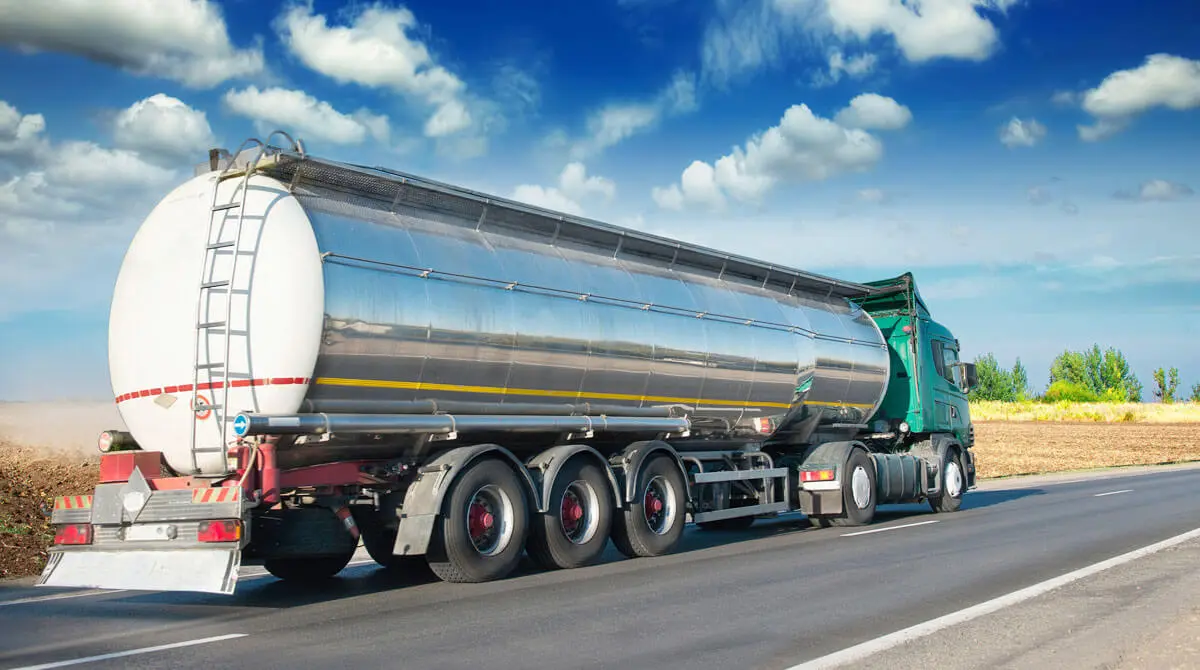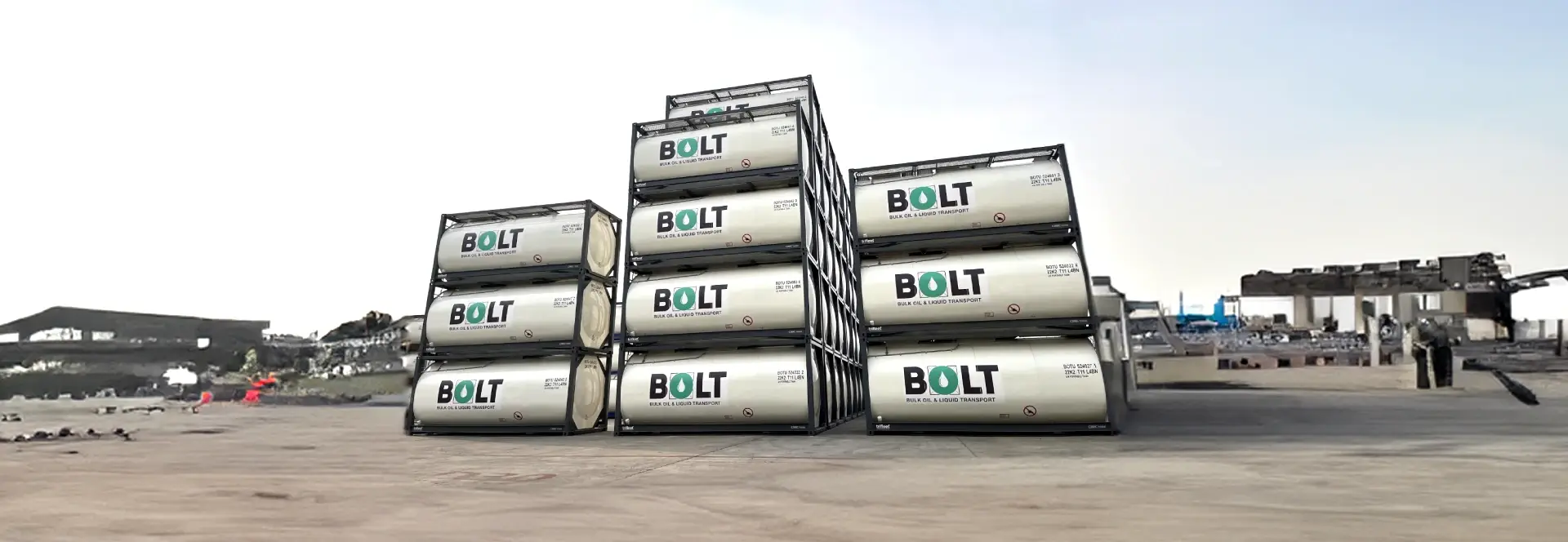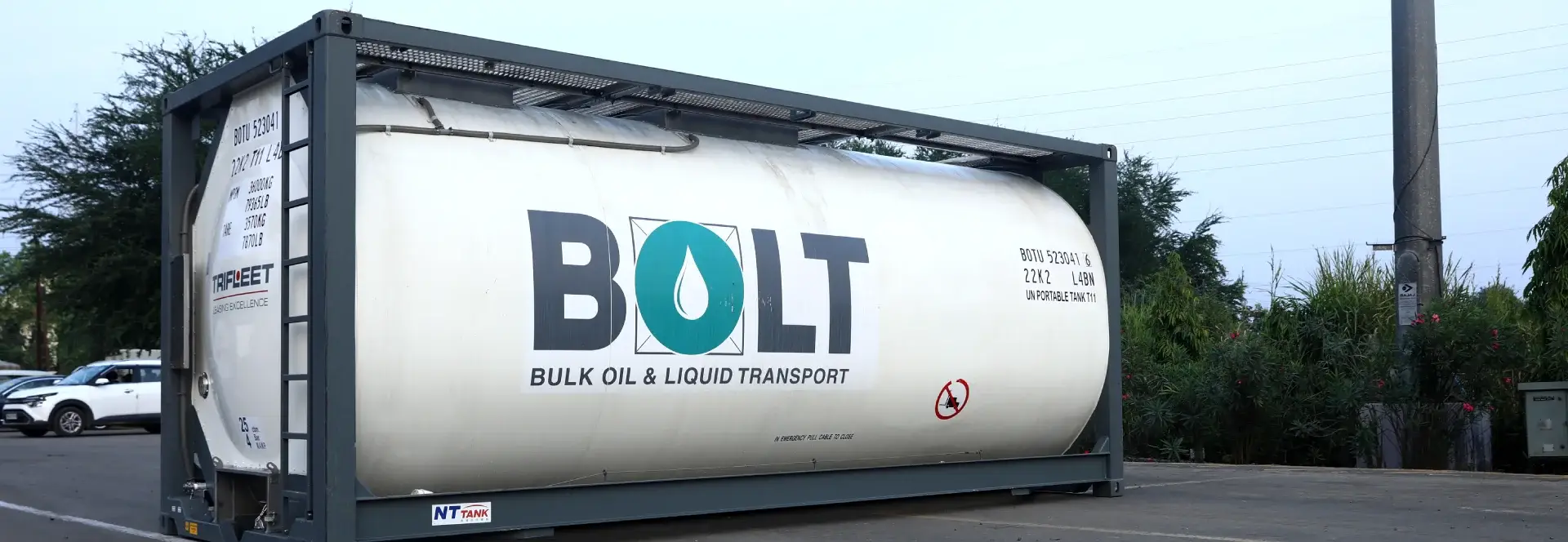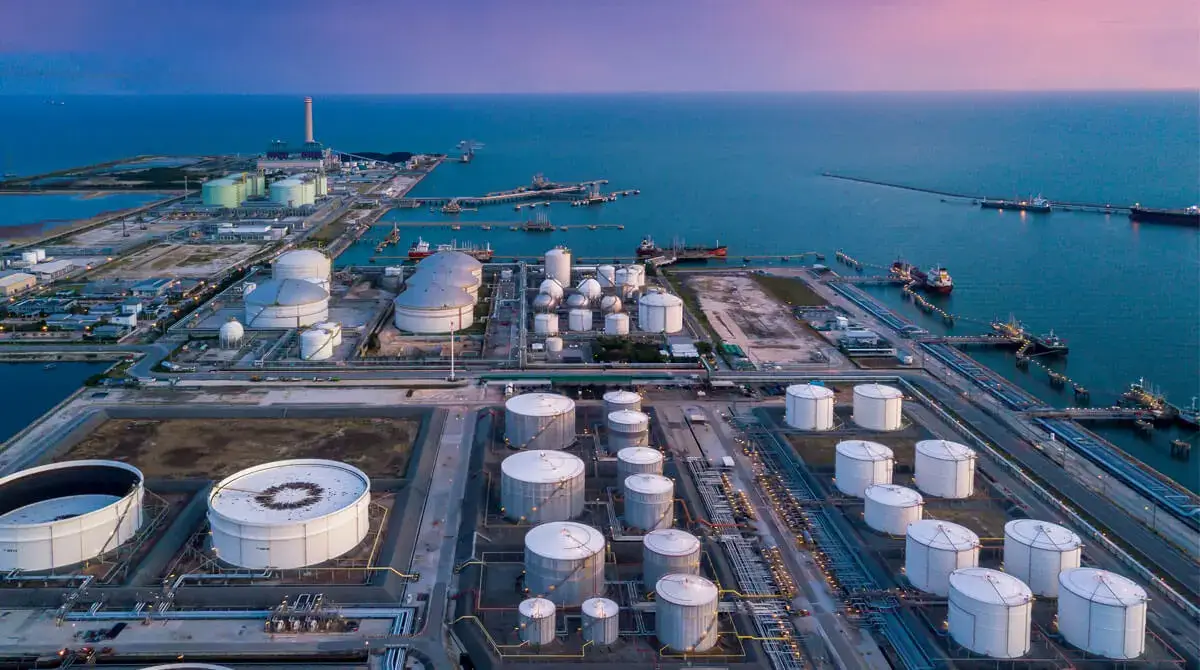
Maximum Permitted Degree of Filling of ISO Tank Containers
When dangerous goods are transported in ISO tank containers (called Portable Tanks in the international dangerous goods regulations), there are rules concerning how full they may be. What you can be absolutely sure of is that to fill an ISO tank container 100% full is completely forbidden. Such a filling level would both be unsafe and illegal. Why? Well one reason is that many substances transported in tank containers are what we call “volatile”, meaning easily and quickly turn from liquid to vapour. This vapour will cause a rise in pressure inside the tank shell. If this process goes on for long enough it could eventually lead to over-pressurisation to the extent of risking bursting the tank into piece. Clearly we do not want this to happen.
At a more straightforward level, the action of the sun beating down on our ISO tank containers may cause the temperature of the cargo inside the tank to expand in volume, also potentially leading to rupture of the tank shell. This can happen even if the ISO tank container is insulated.
These safety issues are recognised in the dangerous goods regulations. There are rules laid down in, for example, the International Maritime Dangerous Goods Code (IMDG Code) telling us how full an ISO tank container is allowed to be for:
- Lesser liquid dangerous goods loaded at ambient temperature
- The more dangerous liquid dangerous goods loaded at ambient temperature
- Molten substances loaded hot
- Pressure liquefied gas tanks
- Tanks filled with deeply refrigerated liquefied gases (cryogenic gases)
In these discussions I want to concentrate on the first three of these.
There is a general misconception which I commonly encounter in the tank container industry among both consignors/shippers and tank container operators that the permitted maximum filling level for tanks filled with liquids is 95% (a rule of thumb as we say). I want to say vehemently that this so-called rule does not exist and, if applied by consignors/shippers and tank container operators may lead to a tank becoming filled beyond a level allowed in law and deemed to be safe by organisations such as the United Nations Committee of Experts on the Transport of Dangerous Goods and the GHS. This committee is the top committee world-wide for the purposes of how to work safely with the transport and supply of dangerous goods. At one time I was a member of this committee representing the tank container industry and had a hand in developing these rules.
Taking liquids loaded at ambient temperature (the IMDG Code assumes this to be 15oC) there are two formulae which must be completed for each load. Which of these two formulae you have to use which I will come to in a moment is determined by the degree of danger a substance has in its transport class. If you look in column (13) of Table A of the Dangerous Goods List, Chapter 3.2 in the IMDG Code Volume 2 at the applicable UN number and Packing Group for your liquid dangerous goods you will find the Portable Tank Provision(s) (TP Codes) applicable to your product. For substances loaded into ISO tank containers at ambient temperatures, one or other of these two codes – TP1 or TP2 apply.
For substances loaded hot including in the molten state, meaning having a melting point temperature greater than 20oC a third one of these applies, TP3.
To find the meaning of these three TP codes by turning to paragraph 4.2.5 in Chapter 4.2 of the Code, Volume 1. In fact this paragraph forms the last two or three pages of this chapter. All these TP codes are listed there. TP1 asks you to turn back in the same chapter to subparagraphs 4.2.1.9.2 and 4.2.1.9.3 earlier on in the chapter and to use the formula:
97
% maximum degree of filling = ---------------
1+ α (tr – tf)
TP2 asks you to use the more restrictive formula:
95
% maximum degree of filling = ---------------
1+ α (tr – tf)
The term α in each formula, represented by the lower case Greek letter alpha is determined by another formula:
α = d15 - d50
------------=
d50 x 35
Tr is a reference temperature taken to be 50oC unless the competent authority (a government official) has authorized a lower temperature to be used. This is the maximum temperature to which the sun could possibly heat a cargo inside an ISO tank container even if it was exposed to the sun in the hottest part of the world for a year or more.
Tf is the filling temperature, taken to be 15oC unless you know different and have a significantly lower filling temperature for a liquid.
d15 is the density of the liquid at 15oC.
d50 is the density of the liquid at 50oC.
So in order to determine the maximum degree of filling permitted in a portable tank (e.g. an ISO tank container) you have to know the density of your dangerous good liquid at 15o Celsius and at 50o Celsius. Do you, as a consignor/shipper have these data? Have they been measured by an acceptable scientific method? Unless you have these data and use them in the appropriate formula every time you fill an ISO tank container you may be filling them to a level deemed to be unsafe by the IMDG Code and similar modal dangerous goods transport regulations.
Note that there is an override situation given in 4.2.1.9.3 it says that if the vapour pressure of your liquid substance is more than 175 kPa (1.75 bar) at 65oC then the formula with 95 must be used even if in the Dangerous Goods List your substance is assigned to TP1. Do you have this datum for all your products because again you may be filling ISO tank containers too full by using TP1’s formula instead of the 95 formula? You must know what is the absolute vapour pressure of all your substances at this temperature!
Let’s do a worked example.
The substance ACRYLONITRILE, STABLIZED, Class 3, Subsidiary Hazard 6.1, Packing Group I, UN 1093 is to be shipped in tank containers. A consignor/shipper wishes to ship 22500 kilos. The largest suitable tank container available has a capacity of 26000 litres. Can this consignment be accepted? The substance has a density at the filling temperature, 15oC, of 0.812 and at 50oC of 0.772.
Step 1. Determine the number of litres represented by 22500 kilos of the substance at the filling temperature:
22500 kilos
--------------- = 27709 litres
0.812
Conclusion: a 26000 litre tank container is too small for the shipper’s preferred consignment. The consignor/shipper must be informed as to the maximum permitted quantity that can be loaded in this tank container.
Step 2. From the Dangerous Goods List in the IMDG Code, determine which TP provisions apply to this substance. These are TP2 and TP13.
Consult 4.2.5.3 in the IMDG Code to discover that TP2 is concerned with maximum degrees of filling. TP13 has no bearing on this matter. TP2 directs the reader to the formula in 4.2.1.9.3 of the Code.
This is the formula: 95
--------------------
1 + α(tr – tf)
where α is the coefficient of cubical expansion over a 35oC temperature range.
As already explained tr is the reference temperature to be taken as 50oC unless a lower figure has been authorised by the competent authority and tf is the filling temperature, in this case taken to be 15oC.
Step 3 Calculate the coefficient of cubical expansion:
d15 – d50
α = --------------
35d50
Substituting the two temperatures into the formula:
0.812 – 0.772
α = --------------------
35 x 0.772
0.04
α = -------------
27.02
α = 0.0014803
Step 4 Return to the filling formula, enter the data and calculate the maximum degree of filling as a percentage of the volume of the tank container:
% degree of filling = 95
--------------------
1 + α(tr – tf)
% degree of filling = 95
------------------------------
1 + 0.0014803(50-15)
% degree of filling = 95
------------------------------
1 + 0.0014803(35)
% degree of filling = 95
------------------------------
1 + 0.51805
Maximum permitted% degree of filling = 90.32%
The maximum degree of filling permitted by the IMDG Code of a tank container laden with this substance is 90.32%.
Step 5 Determine the number of litres of capacity of the tank container which can be legally filled with ACRYLONITRILE, STABLIZED:
26000 X 90.32
------------------ = 23478 litres
100
Step 6 The consignor/shipper needs to know the mass of the substance which can be loaded at the filling temperature. We need to equate the maximum permitted degree of filling by volume of 23478 litres to a number of kilos of the substance which can be loaded using its density at the filling temperature
The number of kilos which can be loaded is:
23478 x 0.812 = 19064 kilos
Conclusion: to fill a tank container with ACRYLONITRILE, STABLISED to a degree of filling of more than 90.32% would be illegal (thus demonstrating the fallacy of the commonly used filling limit self-imposed by industry that portable tanks should be limited to 95% filling limit at the filling temperature is wrong. The figures I have used in these calculations are genuine.
Now I come perhaps to the most important reason why tanks should not be overfilled. I they are and there is not enough ullage space, it is possible that the surging of the liquid inside the ISO tank container when the ship carrying it is encountering a big storm and the seas are in turmoil could force open the pressure relief valve and eject liquid through it, not vapour. By doing this a greater and unnecessarily higher level of danger is created.
The dangerous goods regulations have something to say about this. If you look at paragraph 6.7.2.15.1 in Chapter 6.7 of the IMDG Code and in similar places in the other modal dangerous goods regulations, it says that
“6.7.2.15.1 Each pressure relief device shall be situated on top of the shell in a position as near the longitudinal and transverse center of the shell as reasonably practical. All pressure-relief device inlets shall under the maximum filling conditions be situated in the vapour space of the shell and the devices shall be so arranged as to ensure the escaping vapour is discharged unrestrictedly. For flammable substances, the escaping vapour shall be directed away from the shell in such a manner that it cannot impinge upon the shell…..”
This means that the pressure relief valve must always be in contact with the ullage space no matter what is happening to the ISO tank container during bad weather at sea and never, ever, come into contact with the liquid. This is another reason why it is absolutely necessary not to overfill ISO tank containers.
Conclusion: Each liquid dangerous good has its own maximum permitted degree of filling and to overfill them beyond the levels you calculate using TP1, TP2 or TP3 is essential.
By the way the reason why it says in this paragraph of the IMDG Code “For flammable substances, the escaping vapour shall be directed away from the shell in such a manner that it cannot impinge upon the shell” is to reduce the risk of a BLEVE. Now, what on earth is BLEVE?
For substances loaded hot including in the molten state, meaning having a melting point temperature greater than 20oC a third one of these applies, TP3.
To find the meaning of these three TP codes by turning to paragraph 4.2.5 in Chapter 4.2 of the Code, Volume 1. In fact this paragraph forms the last two or three pages of this chapter. All these TP codes are listed there. TP1 asks you to turn back in the same chapter to subparagraphs 4.2.1.9.2 and 4.2.1.9.3 earlier on in the chapter and to use the formula:
97
% maximum degree of filling = ---------------
1+ α (tr – tf)
TP2 asks you to use the more restrictive formula:
95
% maximum degree of filling = ---------------
1+ α (tr – tf)
The term α in each formula, represented by the lower case Greek letter alpha is determined by another formula:
α = d15 - d50
------------=
d50 x 35
Tr is a reference temperature taken to be 50oC unless the competent authority (a government official) has authorized a lower temperature to be used. This is the maximum temperature to which the sun could possibly heat a cargo inside an ISO tank container even if it was exposed to the sun in the hottest part of the world for a year or more.
Tf is the filling temperature, taken to be 15oC unless you know different and have a significantly lower filling temperature for a liquid.
d15 is the density of the liquid at 15oC.
d50 is the density of the liquid at 50oC.
So in order to determine the maximum degree of filling permitted in a portable tank (e.g. an ISO tank container) you have to know the density of your dangerous good liquid at 15o Celsius and at 50o Celsius. Do you, as a consignor/shipper have these data? Have they been measured by an acceptable scientific method? Unless you have these data and use them in the appropriate formula every time you fill an ISO tank container you may be filling them to a level deemed to be unsafe by the IMDG Code and similar modal dangerous goods transport regulations.
Note that there is an override situation given in 4.2.1.9.3 it says that if the vapour pressure of your liquid substance is more than 175 kPa (1.75 bar) at 65oC then the formula with 95 must be used even if in the Dangerous Goods List your substance is assigned to TP1. Do you have this datum for all your products because again you may be filling ISO tank containers too full by using TP1’s formula instead of the 95 formula? You must know what is the absolute vapour pressure of all your substances at this temperature!
Let’s do a worked example.
The substance ACRYLONITRILE, STABLIZED, Class 3, Subsidiary Hazard 6.1, Packing Group I, UN 1093 is to be shipped in tank containers. A consignor/shipper wishes to ship 22500 kilos. The largest suitable tank container available has a capacity of 26000 litres. Can this consignment be accepted? The substance has a density at the filling temperature, 15oC, of 0.812 and at 50oC of 0.772.
Step 1. Determine the number of litres represented by 22500 kilos of the substance at the filling temperature:
22500 kilos
--------------- = 27709 litres
0.812
Conclusion: a 26000 litre tank container is too small for the shipper’s preferred consignment. The consignor/shipper must be informed as to the maximum permitted quantity that can be loaded in this tank container.
Step 2. From the Dangerous Goods List in the IMDG Code, determine which TP provisions apply to this substance. These are TP2 and TP13.
Consult 4.2.5.3 in the IMDG Code to discover that TP2 is concerned with maximum degrees of filling. TP13 has no bearing on this matter. TP2 directs the reader to the formula in 4.2.1.9.3 of the Code.
This is the formula: 95
--------------------
1 + α(tr – tf)
where α is the coefficient of cubical expansion over a 35oC temperature range.
As already explained tr is the reference temperature to be taken as 50oC unless a lower figure has been authorised by the competent authority and tf is the filling temperature, in this case taken to be 15oC.
Step 3 Calculate the coefficient of cubical expansion:
d15 – d50
α = --------------
35d50
Substituting the two temperatures into the formula:
0.812 – 0.772
α = --------------------
35 x 0.772
0.04
α = -------------
27.02
α = 0.0014803
Step 4 Return to the filling formula, enter the data and calculate the maximum degree of filling as a percentage of the volume of the tank container:
% degree of filling = 95
--------------------
1 + α(tr – tf)
% degree of filling = 95
------------------------------
1 + 0.0014803(50-15)
% degree of filling = 95
------------------------------
1 + 0.0014803(35)
% degree of filling = 95
------------------------------
1 + 0.51805
Maximum permitted% degree of filling = 90.32%
The maximum degree of filling permitted by the IMDG Code of a tank container laden with this substance is 90.32%.
Step 5 Determine the number of litres of capacity of the tank container which can be legally filled with ACRYLONITRILE, STABLIZED:
26000 X 90.32
------------------ = 23478 litres
100
Step 6 The consignor/shipper needs to know the mass of the substance which can be loaded at the filling temperature. We need to equate the maximum permitted degree of filling by volume of 23478 litres to a number of kilos of the substance which can be loaded using its density at the filling temperature
The number of kilos which can be loaded is:
23478 x 0.812 = 19064 kilos
Conclusion: to fill a tank container with ACRYLONITRILE, STABLISED to a degree of filling of more than 90.32% would be illegal (thus demonstrating the fallacy of the commonly used filling limit self-imposed by industry that portable tanks should be limited to 95% filling limit at the filling temperature is wrong. The figures I have used in these calculations are genuine.
Now I come perhaps to the most important reason why tanks should not be overfilled. I they are and there is not enough ullage space, it is possible that the surging of the liquid inside the ISO tank container when the ship carrying it is encountering a big storm and the seas are in turmoil could force open the pressure relief valve and eject liquid through it, not vapour. By doing this a greater and unnecessarily higher level of danger is created.
The dangerous goods regulations have something to say about this. If you look at paragraph 6.7.2.15.1 in Chapter 6.7 of the IMDG Code and in similar places in the other modal dangerous goods regulations, it says that
“6.7.2.15.1 Each pressure relief device shall be situated on top of the shell in a position as near the longitudinal and transverse center of the shell as reasonably practical. All pressure-relief device inlets shall under the maximum filling conditions be situated in the vapour space of the shell and the devices shall be so arranged as to ensure the escaping vapour is discharged unrestrictedly. For flammable substances, the escaping vapour shall be directed away from the shell in such a manner that it cannot impinge upon the shell…..”
This means that the pressure relief valve must always be in contact with the ullage space no matter what is happening to the ISO tank container during bad weather at sea and never, ever, come into contact with the liquid. This is another reason why it is absolutely necessary not to overfill ISO tank containers.
Conclusion: Each liquid dangerous good has its own maximum permitted degree of filling and to overfill them beyond the levels you calculate using TP1, TP2 or TP3 is essential.
By the way the reason why it says in this paragraph of the IMDG Code “For flammable substances, the escaping vapour shall be directed away from the shell in such a manner that it cannot impinge upon the shell” is to reduce the risk of a BLEVE. Now, what on earth is BLEVE?
A typical combined pressure and vacuum relief valve with bursting disc and flame trap.
The tell-tale pressure relief gauge is located in the space above the bursting disc and below the relief valve as a means of detecting rupture of the bursting disc.
All you can see of the bursting disc is its tale with the specification details.
Roy Boneham
Principal Consultant



